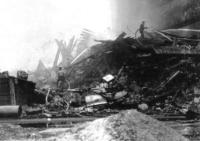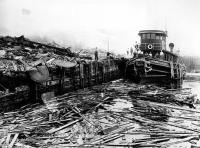 At around 2 a.m. on the Sunday morning of July 30, 1916, one hundred years ago today, explosions on Black Tom Island rocked New York harbor. The blasts lit the night sky and shook the earth with the force of a Richter scale 5.5 earthquake. Black Tom Island, located on the New Jersey side of the harbor, was one of the largest munitions terminals in the country, storing and shipping millions of tons of ammunition and high explosives to the French and the British, who were in the second year of what was then called the “Great War” against Germany and it allies.
At around 2 a.m. on the Sunday morning of July 30, 1916, one hundred years ago today, explosions on Black Tom Island rocked New York harbor. The blasts lit the night sky and shook the earth with the force of a Richter scale 5.5 earthquake. Black Tom Island, located on the New Jersey side of the harbor, was one of the largest munitions terminals in the country, storing and shipping millions of tons of ammunition and high explosives to the French and the British, who were in the second year of what was then called the “Great War” against Germany and it allies.
The explosions that rocked the harbor were an estimated two million pounds of munitions detonating, sending bullets and shrapnel flying into the night, seriously damaging the nearby Statue of Liberty. Thousands of windows in the skyscrapers of downtown Manhattan and in Brooklyn were blown out. Windows as far north as Time Square in midtown were also shattered. In Jersey City, the outer wall of City Hall was cracked and the stained glass windows at St. Patrick’s Church were smashed. The clock tower of The Jersey Journal building in Journal Square, over a mile away, was struck by debris, stopping the clock at 2:12 a.m. Five hundred immigrants at Ellis Island were evacuated. The blasts were heard and felt for, at least, 90 miles in every direction, as far as Maryland and Connecticut. In Philadelphia, residents were woken up by the explosions.
 Remarkably, although hundreds were injured, fewer than ten people are believed to have died. The damage was estimated at more than $20 million or nearly half a billion in today’s dollars.
Remarkably, although hundreds were injured, fewer than ten people are believed to have died. The damage was estimated at more than $20 million or nearly half a billion in today’s dollars.
What happened? Initially it was assumed to be an industrial accident. Two nightwatchmen, who had lit flaming smudge pots to control the mosquitoes, were immediately arrested, and then released when it became clear that the pots had not been the cause of the explosions. Only years later, after the end of World War I was it determined that the explosions had been an act of sabotage organized by German agents. In 1939 after seventeen years of deliberation, the German-American Mixed Claims Commission ruled that Germany was responsible for the sabotage. Germany was ordered to pay reparations of $50 million to all claimants, but the restitution was not paid due to the intervention of World War II. After the war, Germany agreed to settle on outstanding war claims that included those related to the Black Tom explosion. The final payments were not made until 1979.
Black Tom has often been called a terrorist attack. It wasn’t at least not by the legal definition of terrorism. The U.S. Code of Federal Regulations defines terrorism as “the unlawful use of force and violence against persons or property to intimidate or coerce a government, the civilian population, or any segment thereof, in furtherance of political or social objectives…”
The German agents were not attempting to terrorize, intimidate or coerce. The United States in 1916 was nominally neutral even though American firms were able to sell anything they wished to either side although the British naval blockade of German ports cut out German as a potential customer of the American munitions factories. The German agent’s only goal was to stop or reduce the flow of arms and munitions from New York harbor to Britain and France, preferably without jeopardizing American neutrality. On the last point, they largely succeed. The US did enter the war in 1917, but it did not do so because of Black Tom. President Wilson only gave up on neutrality and declared war after the Germans resumed unrestricted submarine warfare and attempted to form a military alliance with Mexico.
The Statue of Liberty’s torch has been closed to the public since the explosion. Prior to the July 1916 explosion visitors could climb a precarious ladder in her arm to enjoy the view from the torch. That ended with damage from the Black Tom explosion.
The island named Black Tom no longer exists. Landfill has made Black Tom Island part of the what is now Liberty State Park in Jersey City. Much of what was Black Tom is now a pick-nick area and children’s playground at the end of Morris Pesin Drive in the southeastern corner of the park. A plaque marks the spot of the explosion. A circle of American flags complements the plaque, which stands east of the visitors’ center.

Hey Rick: My grandfather, William Henry Wright, was a tugboat captain / pilot and I have been told, towed some of the burning barges away from the piers after the explosions when there was still a lot of unexploded ordinance in danger of going off. According to family lore, and his obituary, he had a channel or something on the east coast named after him for his heroism. I have not been able to verify any of that. Any thoughts about how I might
Thank you for pointing out that the sabotage of the munitions depot at Black Tom was not an act of terrorism. I’ve just published a novel about the event and have been searching over the last few days for all the stories that note the centenary and I think yours is the only one that doesn’t call the sabotage terrorism. It really makes you wonder how such an obvious falsehood can be repeated again and again. Bob, I read (and wrote) about the bravery of the tugboat captains and crews. They are truly some of the heroes of that night.
It was interesting reading your account of the Black Tom Island incident. I’ve seldom ever heard it mentioned in recent decades. My grandfather, Charles T. Lark, Sr., was one of the key attorneys handling the Black Tom cases which followed the terrible explosions. I’d like to read more about the incident and its aftermath.
Two good books that deal with the incident and its aftermath are those by Jules Witcover and Chad Millman.
Pingback: Explosion in New York Harbor | Shipmodelsuperstore's Blog